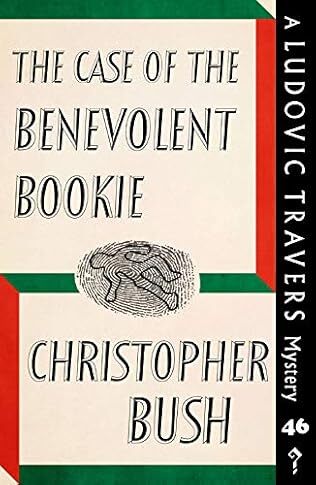The Case Of The Benevolent Bookie

A review of The Case of the Benevolent Bookie by Christopher Bush – 241210
Originally published in 1955 and reissued by Dean Street Press, The Case of the Benevolent Bookie is the forty-sixth in Bush’s long-running Ludovic Travers series. In characteristic Bush style there are three strands to the story.
As owner of the Broad Street Detective Agency Travers is contacted by Lord Tynworth, described somewhat pejoratively as the son of a Labour peer with the implication that he has no breeding. Insisting that Travers drives him to the airport, on the journey Tynworth tells him that his wife, a former crooner, has disappeared taking some “valuables” and gives him an advance of £200 to find where she is. Once located, Travers is to make contact with a Henry Balfour by means of a personal advert and leave the rest to him.
Despite his misgivings, and deprived of a full frontal view of his client – he can only remember a mole – Travers takes on the case and relatively easily discovers her whereabouts. Then, as a hired investigator on behalf of an insurance company, he is called in to locate the Lammaford jewels insured for £50,000. Of course, these are the jewels that Tynworth claimed his wife had taken, but by this time Tynworth too had disappeared to America and as he was in financial difficulties, the assumption is that he took the stones either to sell or as collateral for a loan. There is a replica set of jewels and so another key consideration is who has which set and an attempt to pass one set off for the other leads to the demise of one of the principals.
The third strand sees Travers resume his old role as a consultant to George Wharton of the Yard as the jewellery twist takes a macabre turn and the body of Tynsworth is found under the remains of a burnt haystack and then a second body, that of Ronald Fane, is discovered. Meanwhile someone takes the trouble to have a pop shot at Travers, grazing his shoulder, and in the denouement bot he and Wharton have a gun waved at them.
Of course, all three strands are inter-related and it takes the mole and a teddy bear for Travers to unravel the mystery and point the finger conclusively at the culprit. Frankly, the identity of the culprit is pretty obvious and while there is some ingenuity in the plotting, this is not one of Bush’s better efforts.
Tynworth runs a racing stable and gambling, or at least the consequences of it, hence the book’s title, forms much of the motivation for the pickle that he finds himself in. Curiously, though, Bush makes little of the racing theme, making it just another setting, a little more exotic, say, than a business or a country house but just a backdrop nonetheless. One imagines that Brian Flynn, for example, would leave the reader with the smell of the turf permeating their nostrils. Then there is Bush’s tendency to repeat major plot devices. This is another story where a double from the acting profession is used to confuse, a tendency that began with the second Travers novel, The Perfect Murder Case, and where a physical characteristic or tic proves telling.
Bush is at least consistent with his moans about high levels of taxation and his down on crooners, which had been evident since The Case of the Housekeeper’s Hair. I got the sense, rightly or wrongly, that he was a bit curmudgeonly when he wrote this and it made me a bit grumpy too. Still, the saving grace was the return of the Wharton-Travers double act. Nothing seemed to have changed, Wharton a little too eager to jump to conclusions and, of course, to claim credit for an inspired theory of Travers’ and just as anxious to distance himself from anything that flops. Their interrelationship brightened up the novel for me.
A tale that kept its momentum but, ultimately, one that missed being a winner by a length and a half.



